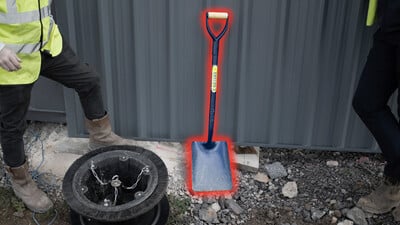Any groundworker will know that even in these days of mechanical diggers, the humble shovel is still an invaluable tool for digging into the ground, moving earth and scooping up debris.
Part of the fabric of any building site, they are not an item that gets much attention – but at Drainfast we felt they deserved to shine.
Humans have been moving earth since Neolithic times. Evidence of this comes from animal shoulder blade bones found at various archaeological sites with tell-tale wear-and-tear. They may have been attached to a wooden handle which of course has long since rotted away.
Ancient Romans – with their knowledge of how to work metal and the desire to build – moved shovel design on to be more in keeping with what we use today. Metal and wood proved to be sturdy materials which played an integral role in building roads and ditches – many of which are still in evidence to this day.
It wasn’t until the 1890s though that serious science was applied to the design in relation to usage. American engineer Frederick Winslow Taylor was interested in improving industrial efficiency to increase productivity. Different sizes and shapes of shovel existed but it was Taylor who went about studying which was best used for which purpose.
His studies in a steel production company determined that the optimum weight of a shovel load for a worker was 21pounds. This was neither too much to carry or too light as to be wasteful of the journey of moving products from one place to another.
As materials that need to be shovelled were different weights (ash versus coal for example), he set about purchasing different sized shovels to suit the material so that the shovel could cope with the volume of material while achieving the optimum weight of 21 pounds.
His theory achieved the desired efficiency with productivity quadrupling; shovels went from being one size fits all to being choose a size that’s right for the job in hand.
So what is the right shovel? And what about spades?
There is very little difference between a shovel and spade. Traditionally shovels were used for scooping (shovelling) up debris and spades were used for digging. However, shovels can be equally effective for digging, especially in softer ground.
The main difference is the shape of the blade; spade blades are flat and straight whilst shovel blades have sides to them to help keep debris on the blade. Spades are slightly better at cutting into turf and unbroken ground while shovels win on their ability to hold their load.
Drainfast Choices:
Cable Laying Shovel – 4 inch wide
With a much narrower blade width than a standard shovel (typically around 4 ½ inches), cable laying shovels are designed for digging long, narrow trenches in which pipes and cables are laid. The slim design reduces the amount of soil that needs to be removed to create the trench, saving some manual effort and producing a neat finish.
Tapered Trenching Shovel – 7 inch wide
This is an ideal tool for digging trenches for cable and pipe laying. With a 7 inch wide blade, it is suitable for wider trenches than you might dig using a cable laying shovel.
Square Mouth Shovel – 10 inch wide
With an extra-wide (10 inch) blade, the square mouth shovel is ideal for shovelling out spoil, mixing concrete, backfilling trenches and moving ballast.
Treaded Spade – 7 inch
This heavy-duty spade is ideal for tougher digging tasks when the ground is on the hard side. The integrated treads on the blade increase comfort and protection of the user’s feet.
Fibreglass or Steel Shaft – which to choose?
Fibreglass shafts have the advantage of being durable, robust and water-resistant. Fibreglass does not rust or expand and contract due to humidity and acts as an electrical insulator – which can be a safety benefit when digging around live electrical cables. Fibreglass is lighter in weight than steel.
Steel shafts are heavier than fibreglass – which can be an advantage when digging through tough ground. Steel is strong – and generally less expensive than fibreglass. It is not recommended to use steel shovels when digging around live electricity cables as steel is an excellent electrical conductor.
Solid Socket or Open Socket?
Solid socket shovels are those where the blade and the lower part of the shaft are forged from one piece of steel which makes them more robust. The blade of open socket shovels just has a socket in which the shaft is inserted. All of the shovels stocked by Drainfast are solid socket.
Happy digging!

Written by
Vicki James
Sales & Marketing Coordinator
Vicki is a vital part of the marketing team; from reporting to copywriting, she ensures we complete projects on time.

